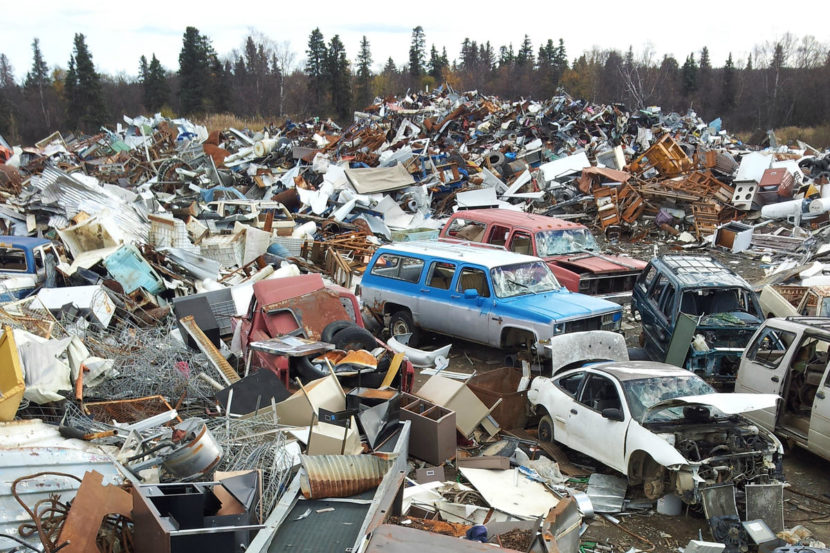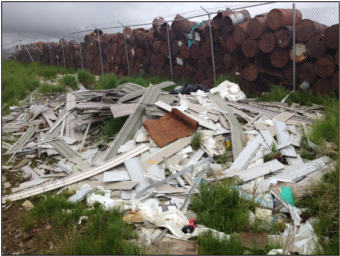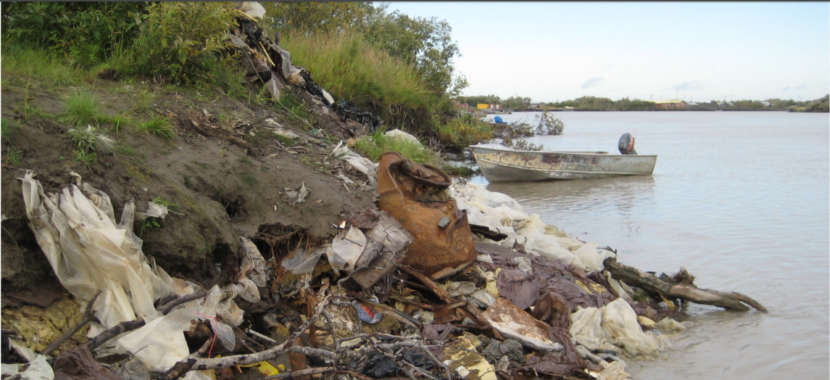
(Photo courtesy KDLG Public Radio)
Pretty much every community in Alaska struggles to get rid of junk like worn-out cars, appliances and electronics, most of which contain hazardous substances that can harm human health. But the problem is especially acute in remote communities located far off the road system, where the stuff accumulates because it’s prohibitively expensive to remove.
“That’s where the struggle is, because from there we really need to take out the material – stuff that’s legacy waste from years ago,” says Doug Huntman who directs the Green Star Program, an effort supported by Anchorage-based Alaska Forum. “But the transportation costs are just so expensive. It’s very difficult to do that.”
A network of partnerships between nonprofit organizations, government agencies and private-sector recycling companies is planning to step up efforts to clean up junk and electronic waste that’s been accumulating for decades in remote communities around Alaska. The partnerships are racing to clean up as much of the stuff as possible by 2020 when federal funding for the projects is scheduled to run out.
Huntman said during a break in the Alaska forum’s environmental conference last week that members of his organization and its partners plan to find out exactly how expensive and difficult that is when they visit those communities this summer to plan cleanups next year.

“We’re going out to the communities on the middle Kuskokwim – which is a tough area in the state – to try and remove that stuff,” he said.
Those communities include Upper and Lower Kalskag, Aniak, Chuathbaluk, Napaimute, Sleetmute, Stony River, Crooked Creek, and possibly Red Devil, said Dave Cannon, the solid-waste coordinator with Aniak-based Kuskokwim River Watershed Council. The council has organized smaller cleanups along the river in recent years and is now working with Huntman to figure out how to remove junk that’s accumulated in those villages.
Cannon says that includes old junk cars, “and in some villages, we have white waste – things like refrigerators, freezers. But batteries, boat and automotive batteries, probably are the biggest concern that we have.”
Cannon says the so-called legacy waste must be loaded onto a barge and taken to Anchorage. But first, it must be drained of hazardous wastes and other such substances. It’s a logistically challenging and costly endeavor. Even more so, because Cannon says it’s not known how much of the stuff is out there. And in some landfills and junkyards, it’s mixed in with other unknown substances.
“There’s a myriad of drums with who knows what materials in them,” he said. “There’s even things like household hazardous waste.”

Cannon says hazardous substances won’t be removed during this initial cleanup. But he says organizers will list them on an inventory they’re putting together. And, where possible, they’ll store them in safe places for pickup later. But another cleanup effort that’s been underway for a couple of years now is mainly focused on removing hazardous materials from remote and rural communities, mainly along the Yukon River. It’s being done by the Solid Waste Alaska Task Force, or SWAT, a consortium of experts from three Alaska nonprofits, the state Department of Environmental Conservation and the federal Environmental Protection Agency.
“Their goal and mission is to create a sustainable way to manage waste in rural communities,” said Becca Brado, executive director of Green Star of Interior Alaska.
Brado says the Fairbanks-based recycling center, not related to the Anchorage-based program, is working with SWAT to help smaller communities backhaul electronic waste, such as old computers and televisions, to recycling companies in Anchorage or even Seattle.
“So Green Star is hoping to serve as a regional hub for Interior villages and communities that don’t have direct access,” she said.
Brado says Green Star is looking for funding to launch an outreach program to promote recycling in more than 60 communities in the Yukon River watershed. She says the program is critically needed because the region lacks adequate landfills or storage facilities. So, much of the e-waste generated in those communities is smashed or dumped outdoors. And that causes hazardous substances in the electronics to seep into the soil and groundwater. Studies show many of those substances, such as heavy metals, make their way up the food chain to the people in the region who depend on wildlife for subsistence.
“With exposure to heavy metals like mercury and lead and other toxic chemicals that children, especially in children, their IQ is actually lowered,” Brado said.

(Public Domain photo courtesy U.S. Department of Agriculture)
Another expert, Lynn Zender, says the chances of exposure to contaminants are even higher when materials are burned, a common practice in communities without landfills.
“Those contaminants can be inhaled, and that’s quite dangers – serious,” said Zender, a member of the SWAT executive committee and head of an Anchorage environmental-consulting firm. And she says there’s growing awareness on the need for better solid- and hazardous-waste disposal in villages. Brado says there’s growing urgency too because funding for an EPA program to promote recycling in remote villages will run out in 2020.
“It’s a race against the clock, really, to try to help these communities get their e-waste and other backhaul materials out by then,” she said.
Brado says she hopes the effort will lead to a sustainable statewide backhauling program that would help clean up villages and keep hazardous e-waste substances out of the ecosystem.
